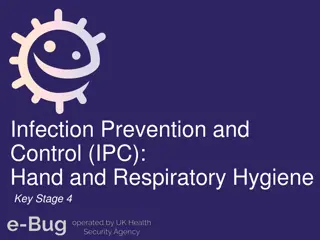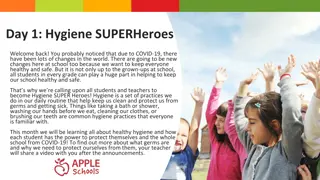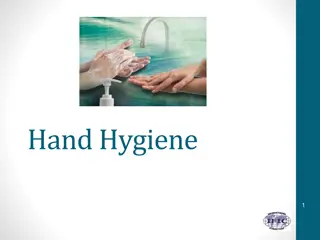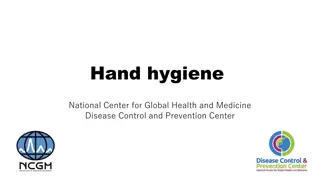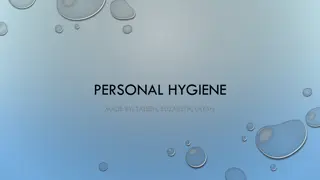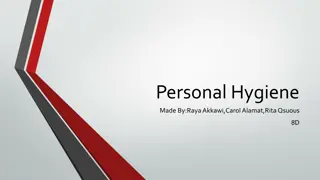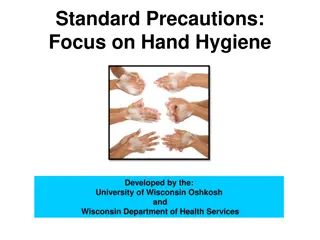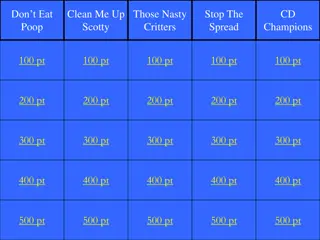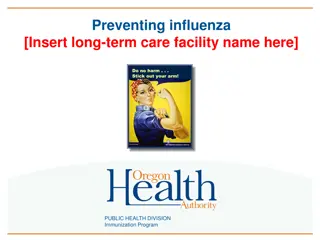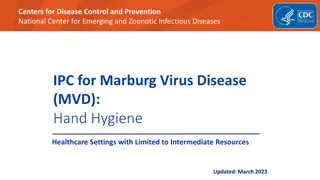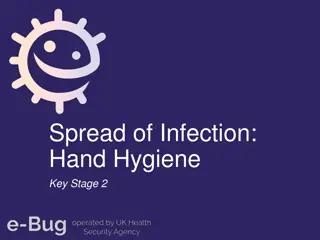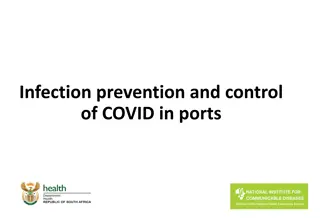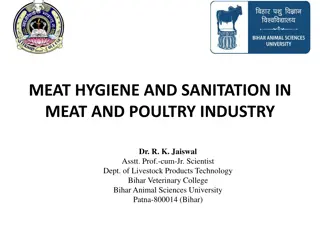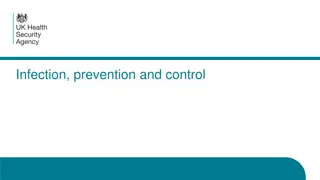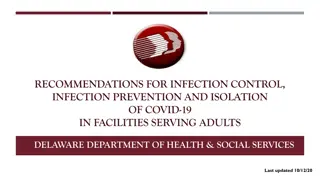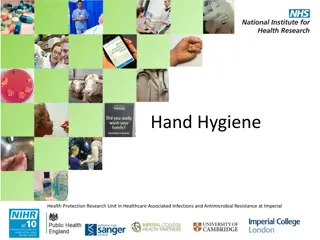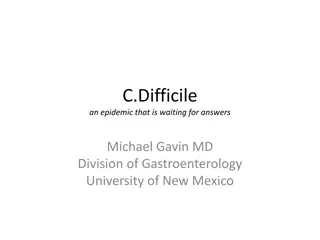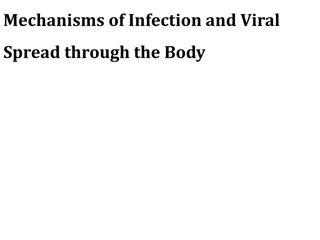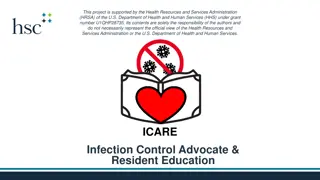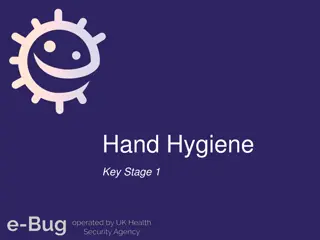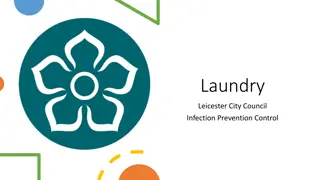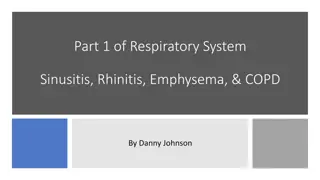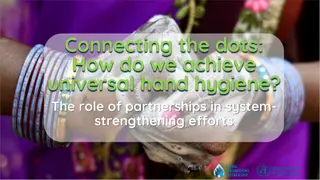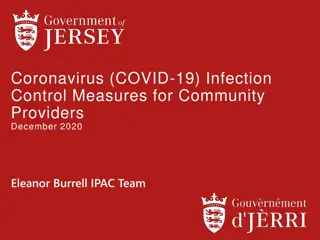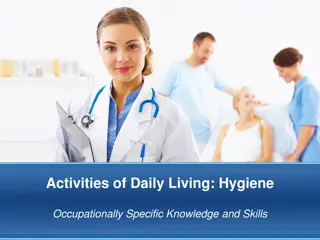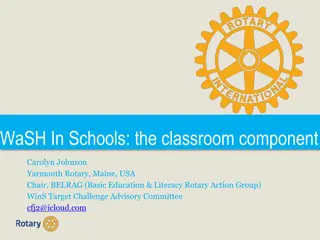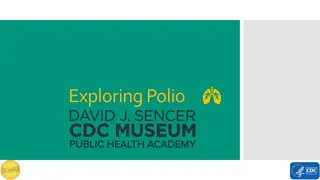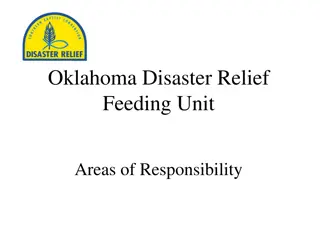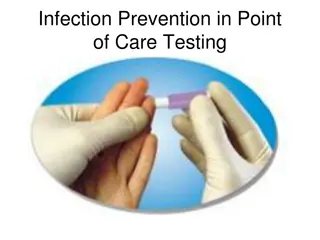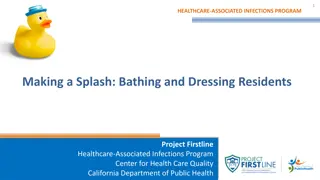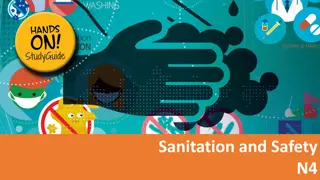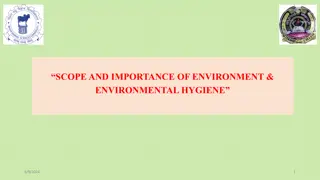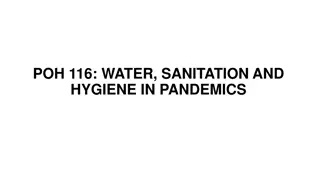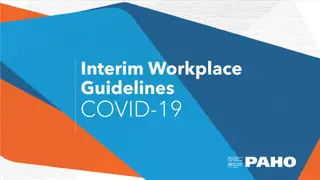Preventing the Spread of Infection Through Respiratory Hygiene
Understand how infections spread through coughs and sneezes, the importance of covering your mouth and nose, and how microbes can be passed from person to person. Learn about the main activities and ways to reduce the spread of infection through good respiratory hygiene practices.
Download Presentation

Please find below an Image/Link to download the presentation.
The content on the website is provided AS IS for your information and personal use only. It may not be sold, licensed, or shared on other websites without obtaining consent from the author. Download presentation by click this link. If you encounter any issues during the download, it is possible that the publisher has removed the file from their server.
E N D
Presentation Transcript
Spread of Infection: Respiratory Hygiene Key Stage 2
Learning Outcomes All students will: Understand that infection can spread through coughs and sneezes. Understand that covering your mouth and nose with a tissue or your sleeve (not your hands) when you cough, or sneeze helps prevent the spread of infection. Understand that coughing and sneezing in your hand can still spread infection. e-Bug.eu
Curriculum Links PHSE/RHSE Health and prevention Science Working scientifically Living things and their habitats Animals, including humans English Reading & comprehension Spoken language Mathematics Comparing measurements e-Bug.eu
How Can Microbes be Passed From Person to Person? Germs (microbes) can be passed from person to person through coughing and sneezing. Although infections can spread from person to person, there are usually a few different ways that we could have been exposed to the germs that caused it. It is usually impossible to know who we caught the infection from and it is important that we all take responsibility for preventing the spread of these germs by properly covering coughs/sneezes, good hand washing and not touching our eyes and face with unwashed hands. e-Bug.eu
How Can Microbes be Passed From Person to Person? Germs that cause some diseases are so small that they can travel through the air in water droplets when people cough or sneeze. Diseases spread in this way range from the common cold to rarer or more serious infections such as tuberculosis (TB). Cold and flu, are caused by viruses and not bacteria. It is very important for everyone s health that people cover their mouth and nose with a tissue when they cough and sneeze, or to sneeze into the crook of their elbow if they do not have a tissue. The spread of infection can be reduced through good respiratory hygiene. e-Bug.eu
Main Activity: Super Sneeze e-Bug.eu
2. Spray the bottle from the end of runway 3. Measure the distance 4. Spray the bottle with hand of glove over nozzle 5. Spray the bottle with kitchen towel over the nozzle 1. Write your name on a sticky note and place on runway e-Bug.eu
Discussion e-Bug.eu
Discussion Points What is the outcome of their results? Why you may want to sneeze into the crook of your elbow or sleeve if no tissue is available? If sneezing in your hand what can spread to things that we touch? What do we do next when we sneeze/cough? If we do not have a tissue how do we sneeze/cough? e-Bug.eu
Extension Activities e-Bug.eu
Super Sneezes My Observations How far did your sneeze travel Student 1 Student 2 Student 3 Student 4 Student 5 Sneeze Length (cm) Width (cm) Sneeze with hand Length (cm) Width (cm) Sneeze with tissue Length (cm) Width (cm) e-Bug.eu
Super Sneezes 1. What do you think will happen when you put the hand over the mouth to sneeze? Make a prediction. _____________________________________________________________ 2. What do you think will happen when you put the tissue over the mouth to sneeze? Make a prediction. _____________________________________________________________ 3. What actually happened when the hand was over the mouth to sneeze? (Where and how far did the sneeze travel?) ______________________________________________________________ 4. What actually happened when the tissue was over the mouth to sneeze? (Where and how far did the sneeze travel?) ______________________________________________________________ e-Bug.eu
Super Sneezes My Conclusions 1.Why is hand hygiene important after coughing and sneezing? _________________________________________________ _________________________________________________ _________________________________________________ 2.What can we do to stop germs spreading from person to person? _________________________________________________ _________________________________________________ _________________________________________________ _________________________________________________ _________________________________________________ e-Bug.eu
Super Sneezes - Answers My Observations How far did your sneeze travel Student 1 Student 2 Student 3 Student 4 Student 5 Sneeze Length (cm) Width (cm) Sneeze with hand Length (cm) Your Observations Width (cm) Sneeze with tissue Length (cm) Width (cm) e-Bug.eu
Super Sneezes - Answers 1. What do you think will happen when you put the hand over the mouth to sneeze? Make a prediction. _____________________________________________________________ _____________________________________________________________ people. The sneeze travelled less far than when uncovered and reached fewer 2. What do you think will happen when you put the tissue over the mouth to sneeze? Make a prediction. _____________________________________________________________ _____________________________________________________________ and reached fewer people. The sneeze travelled less far than when uncovered or cover by hand 3. What actually happened when the hand was over the mouth to sneeze? (Where and how far did the sneeze travel?) ______________________________________________________________ ______________________________________________________________ ______________________________________________________________ reached fewer people. The sneeze was mainly contained by the hand, which is now contaminated. The sneeze travelled less far than when uncovered and 4. What actually happened when the tissue was over the mouth to sneeze? (Where and how far did the sneeze travel?) ______________________________________________________________ ______________________________________________________________ ______________________________________________________________ The hand holding the tissue is contaminated. The sneeze was contained by the tissue. The sneeze travelled less far than when uncovered or covered by the hand and reached fewer people. e-Bug.eu
Super Sneezes - Answers My Conclusions 1.Why is hand hygiene important after coughing and sneezing? _________________________________________________ _________________________________________________ _________________________________________________ _________________________________________________ transmitted to other people through touch. When covering sneezes with hands or tissues the hands are exposed to numerous microbes. If left unwashed, these potentially contagious microbes can be 2.What can we do to stop germs spreading from person to person? _________________________________________________ _________________________________________________ _________________________________________________ _________________________________________________ _________________________________________________ the crook of the elbow or sleeve. Cover coughs and sneezes, preferably with a tissue, and bin the tissue and wash hands with antimicrobial soap and water immediately. If a tissue is unavailable, sneezes should be covered by e-Bug.eu
Respiratory Hygiene Quiz After we sneeze into our hands, we should: (2 points) How can you spread microbes to others? (3 points) Wash our hands Dry our hands on our clothes Take antibiotics None of the above is necessary Touching Sleeping Sneezing Coughing e-Bug.eu
Respiratory Hygiene Quiz The best way to stop microbes from spreading is: (2 points) If you do not have a tissue available, the best option from the following is to sneeze: (1 point) To use your hand to cover your sneeze To use a tissue to cover your sneeze To use a sleeve if you haven t got a tissue To drink plenty of fluids Into your hands Into your sleeve Into an empty space Onto your desk e-Bug.eu
Respiratory Hygiene Quiz What should you do with a tissue after sneezing into it? (1 point) What might happen if we don t wash our hands after sneezing into them? (1 point) Put it in your pocket for next time Put it straight in the bin Put it up your sleeve for next time Any of the above Nothing Transfer harmful microbes to other people Help protect our microbes e-Bug.eu
Respiratory Hygiene Quiz - Answers After we sneeze into our hands, we should: (1 points) How can you spread microbes to others? (3 points) Wash our hands Dry our hands on our clothes Take antibiotics None of the above is necessary Touching Sleeping Sneezing Coughing e-Bug.eu
Respiratory Hygiene Quiz - Answers The best way to stop microbes from spreading is: (2 points) If you do not have a tissue available, the best option from the following is to sneeze: (1 point) To use your hand to cover your sneeze To use a tissue to cover your sneeze To use a sleeve if you haven t got a tissue To drink plenty of fluids Into your hands Into your sleeve Into an empty space Onto your desk e-Bug.eu
Respiratory Hygiene Quiz - Answers What should you do with a tissue after sneezing into it? (1 point) What might happen if we don t wash our hands after sneezing into them? (1 point) Put it in your pocket for next time Put it straight in the bin Put it up your sleeve for next time Any of the above Nothing Transfer harmful microbes to other people Help protect our microbes e-Bug.eu
Respiratory Hygiene Fill in the Blanks _______________ can spread from person to person through the air, through person-to-person contact (touching hands, hugging, kissing) or by touching contaminated surfaces. Colds and flus are the most common type of infection in the classroom and among the most _______________. Common _______________ of a respiratory infection can include _______________, sore throat, _______________, and sometimes a runny or blocked nose. We can prevent microbes being transmitted from person to person by covering our _______________ and _______________ with a tissue and throwing away the tissue immediately. Key words: headaches, hand sanitiser, fever, vaccinations, symptoms, microbes, sneezes, coughs, harmful, contagious We should always wash our hands with soap and water, or _______________ if soap and water are not available, immediately after throwing away the tissue. Although there are many _______________ microbes that can make us ill, we can prevent some infections by getting _______________. e-Bug.eu
Respiratory Hygiene Fill in the Blanks - Answers Infections _______________ can spread from person to person through the air, through person-to-person contact (touching hands, hugging, kissing) or by touching contaminated surfaces. Colds and flus are the most common type of infection in the classroom and among the most _______________. contagious symptoms Common _______________ of a respiratory infection can include _______________, sore throat, _______________, and sometimes a runny or blocked nose. headaches fever We can prevent microbes being transmitted from person to person by covering our _______________ and _______________ with a tissue and throwing away the tissue immediately. sneezes Key words: headaches, hand sanitiser, fever, vaccinations, symptoms, microbes, sneezes, coughs, harmful, contagious coughs We should always wash our hands with soap and water, or _______________ if soap and water are not available, immediately after throwing away the tissue. hand sanitiser harmful Although there are many _______________ microbes that can make us ill, we can prevent some infections by getting _______________. vaccinations e-Bug.eu
Learning Consolidation e-Bug.eu
Create some simple rules or messages to reduce the spread of coughs, colds and flu Catch it, bin it, kill it Coughs and sneezes spread diseases Cover my coughs and sneezes with a tissue or cough/sneeze into the crook of my elbow (not my hand) Wash my hands after a cough or a sneeze or use hand sanitiser e-Bug.eu


